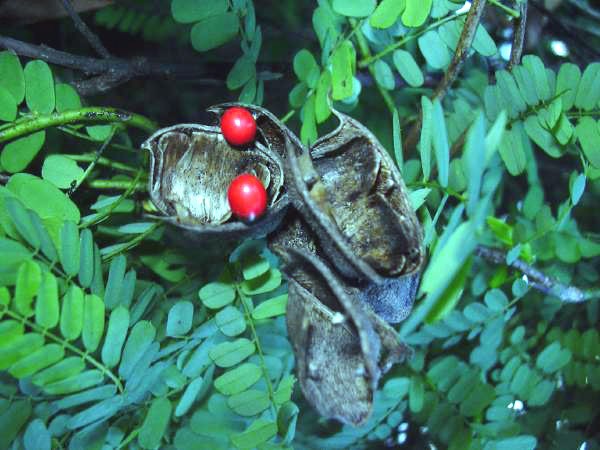The Rosary Pea (Abrus precatorius) is indeed a plant with a fascinating but deadly secret. While it possesses beautiful and vibrant seeds, it is important to recognize its extreme toxicity. Here’s an exploration of the deadly beauty of Rosary Pea and the toxic truth behind it:
1. Attractive Appearance:
- Colorful Seeds: The seeds of the Rosary Pea are small, round, and come in a variety of striking colors, such as red, black, orange, and white. They have a naturally polished look.

- Seed Jewelry: The seeds have been used to make jewelry, including bracelets and necklaces, but this practice is highly discouraged due to the toxic nature of the seeds.
2. Toxic Substance:
- Abrin: The seeds of the Rosary Pea contain a potent toxin called abrin. Abrin is similar to ricin, another well-known plant toxin, and is considered one of the most toxic substances in the world.
- Lethal Dose: Ingesting just one seed can be lethal to humans. The hard seed coat protects the toxin, but if the seed is chewed or broken, abrin can be released.
3. Symptoms of Poisoning:
- Gastrointestinal Distress: Ingesting Rosary Pea seeds can lead to severe abdominal pain, nausea, vomiting, and diarrhea.
- Organ Failure: The toxin affects multiple organs, potentially leading to organ failure and death.
4. Historical Use and Cultural Significance:
- Traditional Medicine: Despite its extreme toxicity, Rosary Pea has been used in traditional medicine in some cultures. However, the risks associated with its use outweigh any potential benefits.
- Cultural Practices: In some regions, the plant has cultural significance, but its use is often discouraged due to the dangers involved.
5. Regulation and Legal Status:
- Regulated Substance: Due to its extreme toxicity, the cultivation, sale, and use of Rosary Pea may be regulated in many places. It is crucial to be aware of and adhere to local regulations.
6. Prevention and Safety Measures:
- Education and Awareness: Public awareness campaigns emphasize the dangers of Rosary Pea, especially in regions where the plant is native.
- Avoiding Contact: It is strongly advised to avoid handling or ingesting any part of the Rosary Pea plant.
7. Environmental Impact:
- Invasive Species: Rosary Pea can be invasive in some regions, impacting local ecosystems. Its rapid growth and spread contribute to its classification as an invasive species.
8. Legal Ramifications:
- Legal Consequences: Deliberate use of Rosary Pea seeds for harmful purposes, such as poisoning, can have severe legal consequences due to the plant’s extreme toxicity.
9. Scientific Interest:
- Research Potential: Despite its toxicity, the compounds found in Rosary Pea seeds, including abrin, have attracted scientific interest for potential applications in medicine and research. However, the risks associated with handling the plant outweigh its potential benefits.
10. Public Health Warnings:
- Health Advisories: Public health warnings are issued to inform the public about the dangers of Rosary Pea, especially in areas where the plant is prevalent.
In summary, while the Rosary Pea may be visually captivating, its deadly toxicity underscores the importance of caution and awareness. Handling or ingesting any part of this plant can have severe and potentially fatal consequences. It is crucial to prioritize safety, avoid intentional use, and adhere to regulations to prevent harm from the toxic compounds present in Rosary Pea seeds.











